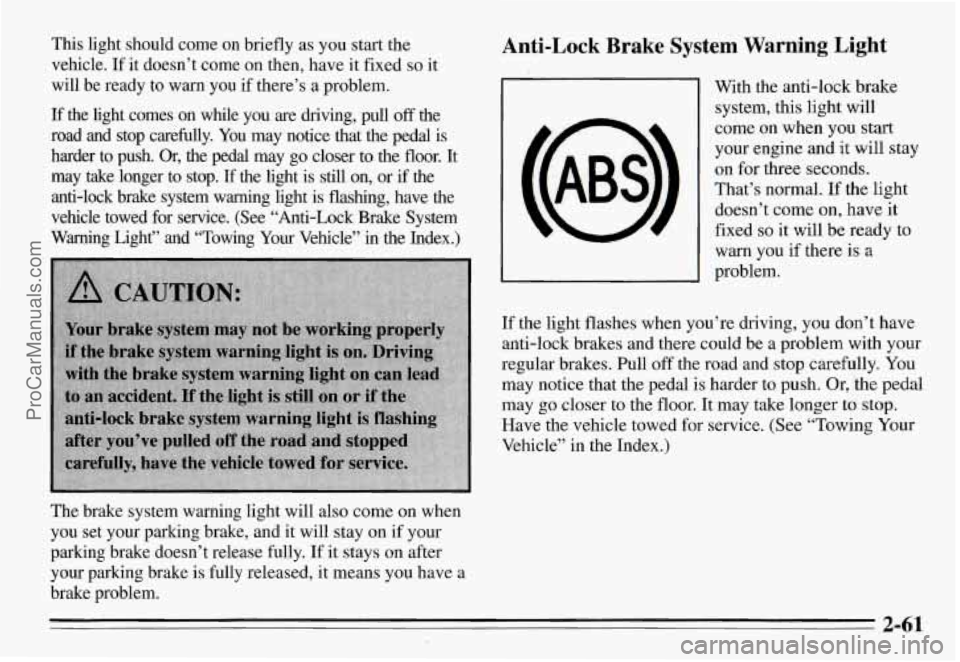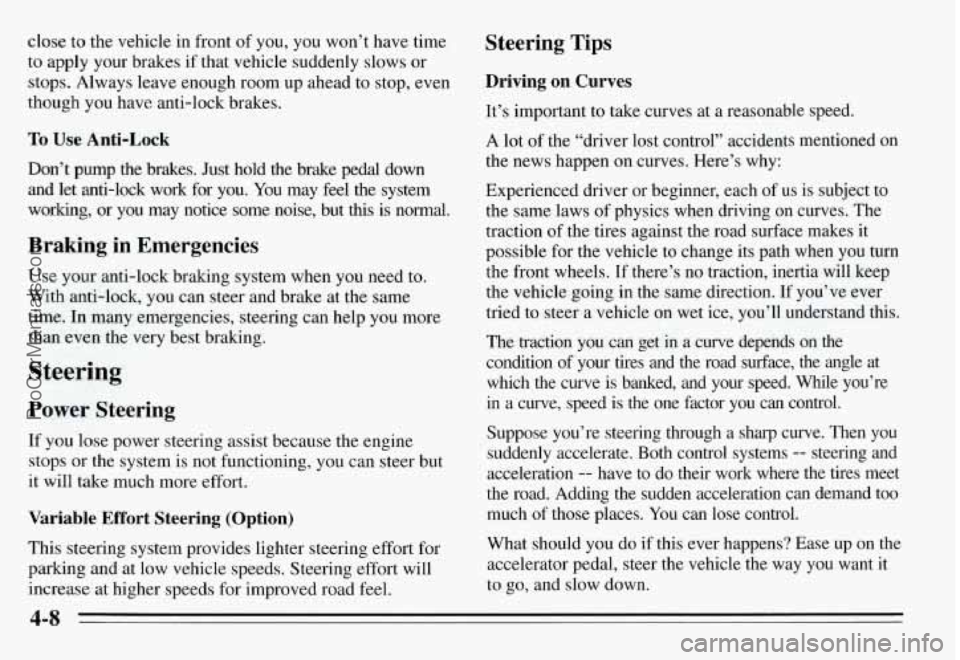Page 108 of 354
i
The main components of your instrument panel are:
1. Fog Lamp Switch
2. Instrument Panel Intensity Control/ Interior Lamps
Switch
3. Side Vent
4. Turn SignaVMultifunction Lever
5. Hazard Warning Flashers Switch
6. Instrument Cluster
7. Windshield WipersNasher Stalk
8. Center Vent
9. Audio System
10. Side Vent
11. Side Window Defogger Vent
12. Glove Box
13. Climate Control System
14. AshtrayLighter
15. Gear Shift Lever
16. Rear Window Defogger (Option)
17. Ignition Switch
18. SRS - Supplemental Restraint System (Air Bag)
19. Horns
20. Tilt Steering Wheel Lever (Option)
21. Parking Brake Release Lever
22. Hood Release Handle
23. Fuse Panel
2-53
ProCarManuals.com
Page 116 of 354

This light should come on briefly as you start the
vehicle. If it doesn’t come on then, have it fixed
so it
will be ready to warn you if there’s a problem.
If the light comes on while you are driving, pull off the
road
and stop carefully. You may notice that the pedal is
harder to push.
Or, the pedal may go closer to the floor. It
may take longer to stop. If the light is still on, or if the
anti-lock brake system warning light is flashing, have the
vehicle towed for service. (See “Anti-Lock Brake System
Warning Light” and “Towing Your Vehicle” in the Index.)
The brake system warning light will also come on when
you set your parking brake, and it will stay
on if your
parking brake doesn’t release fully. If it stays on after
your parking brake is fully released, it means you have a
brake problem.
Anti-Lock Brake System Warning Light
1
With the anti-lock brake
svstem. this lirrht will
8 u
come on when you start
your engine and it will stay
on for three seconds.
That’s normal. If the light
doesn’t come
on, have it
fixed
so it will be ready to
warn you if there is a
problem.
If the light flashes when you’re driving, you don’t have
anti-lock brakes and there could be a problem w-ith your
regular brakes. Pull off the road and stop carefully. You
may notice that the pedal is harder to push.
Or, the pedal
may go closer to the floor. It may take longer to stop.
Have the vehicle towed for service. (See “Towing Your
Vehicle” in the Index.)
2-61
ProCarManuals.com
Page 151 of 354

close to the vehicle in front of you, you won’t have time
to apply your brakes
if that vehicle suddenly slows or
stops. Always leave enough room up ahead to stop, even
though
you have anti-lock brakes.
To Use Anti-Lock
Don’t pump the brakes. Just hold the brake pedal down
and let anti-lock work for you. You may feel the system
working, or
you may notice some noise, but this is normal.
Braking in Emergencies
Use your anti-lock braking system when you need to.
With anti-lock, you can steer and brake at the same
time.
In many emergencies, steering can help you more
than even the very best braking.
Steering
Power Steering
If you lose power steering assist because the engine
stops or the system is not functioning, you can steer but
it will take much more effort.
Variable Effort Steering (Option)
This steering system provides lighter steering effort for
parking and at low vehicle speeds. Steering effort will
increase at higher speeds for improved road feel.
Steering Tips
Driving on Curves
It’s important to take curves at a reasonable speed.
A lot of the “driver lost control” accidents mentioned on
the news happen on curves. Here’s why:
Experienced driver or beginner, each of us is subject to
the same laws of physics when driving on curves. The
traction of the tires against the road surface makes it
possible for the vehicle to change its path when you turn
the front wheels. If there’s no traction, inertia will keep
the vehicle going in the same direction.
If you’ve ever
tried to steer a vehicle on wet ice, you’ll understand this.
The traction you can get in a curve depends on the
condition
of your tires and the road surface, the angle at
which the curve is banked, and your speed. While you’re
in a curve, speed is the
one factor you can control.
Suppose you’re steering through a sharp curve. Then you
suddenly accelerate. Both control systems
-- steering and
acceleration
-- have to do their work where the tires meet
the road. Adding the sudden acceleration can demand too
much
of those places. You can lose control.
What should you do if this ever happens? Ease up on the
accelerator pedal, steer the vehicle the way you want it
to go, and slow down.
4-8
ProCarManuals.com
Page 169 of 354
Recreational Vehicle Towing
There may be times when you want to tow your Pontiac
behind another vehicle for use at your destination. Be
sure to
use the proper towing equipment designed for
recreational towing. Follow the instructions
for the
towing equipment.
Towing Your Vehicle from the Front
m
Follow these steps:
1. ‘Put the front wheels on a dolly.
NOTICE:
Do not tow your Pontiac with the front wheels in
contact with the ground, or the automatic
transaxle could
be damaged.
2.
3.
4.
5.
Set the parking brake.
Turn the ignition key to
OW to unlock the steering
wheel.
See “Ignition” in the Index.
Clamp the steering wheel in a straight-ahead
position, with
a clamping device designed for
towing.
Release the parking brake.
4-26
ProCarManuals.com
Page 170 of 354
If you have a manual transaxle, you can also tow your
vehicle with all four wheels on the ground.
I
Follow these steps:
1. Set the parking brake.
2. Turn the ignition key to OFF to unlock the steering
wheel.
3. Clamp the steering wheel in a straight-ahead
position, with a clamping device designed
for
towing.
4. Shift your manual transaxle to NEUTRAL IN).
5. Release the parking brake.
NOTICE:
Make sure that the towing speed does not exceed
55 mph (90 km/h), or your Pontiac could be
badly damaged.
4-27
ProCarManuals.com
Page 179 of 354

When towing a trailer, the green arrows on your
instrument panel will flash for turns even
if the bulbs on
the trailer
are burned out. Thus, you may think drivers
behind you are seeing your signal when they
are not. It’s
important to check occasionally to be sure the trailer
bulbs
are still working.
Driving On Grades
Reduce speed and shift to a lower gear before you start
down a long or steep downgrade. If you don’t shift
down, you might have to use your brakes
so much that
they would get hot and no longer work well.
On a long uphill grade, use the highest gear possible. If
you cannot maintain posted speeds, driving at a lower
speed may help avoid overheating your engine and
transaxle.
If you have a manual transaxle with fifth gear, it’s better
not
to use fifth gear. Just drive in fourth gear (or, as you
need to, a lower gear).
Parking on Hills
You really should not park your vehicle, with a trailer
attached, on a
hill. If something goes wrong, your rig
could
start to move. People can be injured, and both
your vehicle and the trailer can be damaged.
But if you ever have to park your rig on a hill, here’s
how to do it:
1. Apply your regular brakes, but don’t shift into
PARK (P) yet, or into gear for a manual transaxle.
2. Have someone place chocks under the trailer wheels.
3. When the wheel chocks are in place, release the
regular brakes until the chocks absorb the load.
4. Reapply the regular brakes. Then apply your parking
brake, and then shift to PARK (P), or REVERSE (R)
for a manual transaxle.
5. Release the regular brakes.
4-36
ProCarManuals.com
Page 180 of 354
When You Are Ready to Leave After
Parking on a Hill
1. Apply your regular brakes and hold the pedal down
while you:
Start your engine;
Shift into a gear; and
Release the parking brake.
2. Let up on the brake pedal.
3. Drive slowly until the trailer is clear of the chocks.
4. Stop and have someone pick up and store the chocks.
Maintenance When Trailer Towing
Your vehicle will need service more often when you’re
pulling a trailer. See the Maintenance Schedule for more
on this. Things that are especially important in trailer
operation are automatic transaxle fluid (don’t overfill),
engine oil, belt, cooling system, and brake adjustment.
Each
of these is covered in this manual, and the Index
will help you find them quickly. If you’re trailering, it’s
a good idea to review these sections before you start
your trip.
Check periodically to see that all hitch nuts and bolts are
tight.
4-37
ProCarManuals.com
Page 189 of 354
When your vehicle is being towed, have the ignition key
off. The steering wheel should be clamped in a
straight-ahead position, with a clamping device
designed for towing service. Do not use the vehicle’s
steering column lock for this. The transaxle should be in
NEUTRAL (N) and the parking brake released.
The ignition key must be in the OFF position to prevent
the automatic door locks from locking during towing.
Don’t have your vehicle towed on the front wheels,
unless you must.
If the vehicle must be towed on the
front wheels, don’t go more than
35 mph (55 km/h) or
farther than
50 miles (80 km) or your transaxle will be
damaged.
If these limits must be exceeded, then the
front wheels have to be supported on
a dolly.
ProCarManuals.com